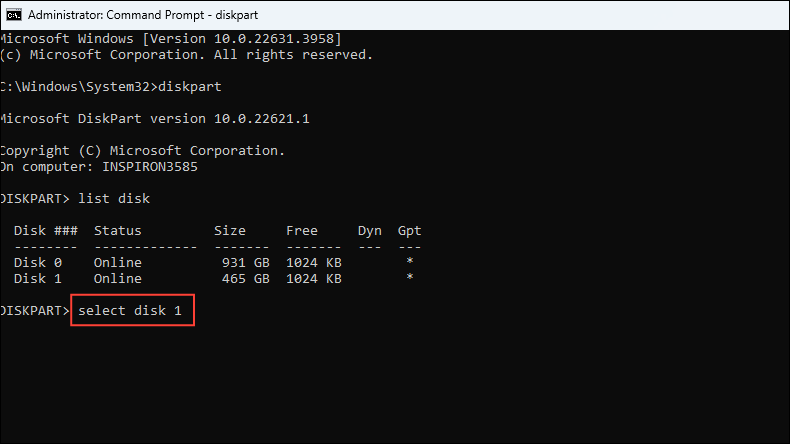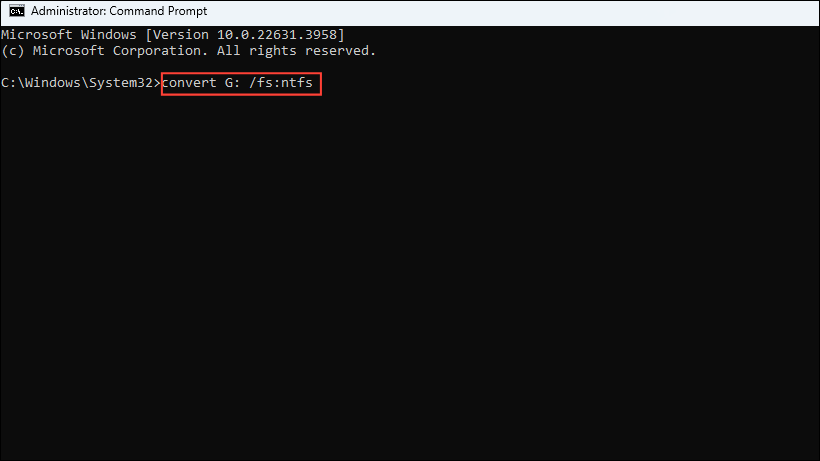- The 'Windows cannot be installed to this disk' error can occur due to various reasons and will require different solutions depending on the cause.
- The simplest solution is to boot to UEFI Mode if you have a GPT disk with a Legacy BIOS.
- If that does not work, you may have to convert the disk from GPT to MBR.
- Alternatively, if the disk has an MBR table but your machine has UEFI, you will need to convert the disk to GPT.
For the 'Selected disk is of the GPT partition style' error
If you get the error "Windows cannot be installed to this disk. The selected disk is of the GPT partition style", it means a Legacy BIOS is present on your PC. You will need to boot to UEFI Mode if it is available. If it isn't, you will have to convert the disk to MBR since Legacy BIOS does not support GPT.
Fix 1: Boot to UEFI Mode
- Start your PC and press the key that lets you enter the BIOS, which can be F12, F10, F2, F1, or Delete, depending on your computer manufacturer and model.
- Look for a 'Boot mode' option, which is usually located under the 'Boot' tab or something similar.
- When you've located it, check whether UEFI is available or not and whether the Boot Mode is set to Legacy. If it is available, select it using the arrow keys.
- Then save changes and exit the BIOS before continuing with the installation.
- If UEFI is unavailable, you will need to convert the disk from GPT to MBR.
Fix 2: Convert the disk to MBR
- You should have the Windows Installation Media ready to start the conversion process. Insert it into your computer and then power it up. When your PC boots, press the boot key that lets you choose between different boot devices. Again, this can vary depending on your computer brand and model.
- When the Windows Setup screen appears, use the
Shift + F10shortcut to open a command prompt window. - Type
diskpartin the window and press the Enter key.

- Next, type
list diskand press Enter to view all the disks connected to your PC. If your machine has a GPT disk, an '*' will appear below the GPT section.

- Make a note of the disk number for the disk you want to convert to MBR. Then select it using the command
select disk #. Replace the # with the disk number.

- Once the disk is selected, type
cleanand press Enter to wipe the disk. Wait until all data on the disk is removed and then typeconvert mbrbefore pressing Enter. - After the conversion is complete, you can close the command prompt window and proceed with the installation.
For the 'Selected Disk Has an MBR Partition Table' error
If you get the error "Selected Disk Has an MBR Partition Table", it means your disk is MBR but the BIOS is UEFI. In such a case, you can first try to disable the EFI boot sources and check whether you can install Windows.
Fix 1: Disable EFI boot sources
- Enter the BIOS and then go to the 'Boot Order' section. Look for 'EFI boot sources' and check whether you can disable it.
- If you can disable it, turn it off and then continue the Windows installation. Once Windows is installed, go back to the BIOS and re-enable EFI boot sources.
Fix 2: Convert the disk to GPT
In case you cannot disable EFI boot sources, you will need to convert the disk from MBR to GPT. You can follow the same process as when converting GPT to MBR. Just replace the convert mbr command with convert gpt. After converting the disk, close the command prompt and continue the installation.
Fix 3: Use Windows Installation media to convert an MBR disk to GPT
An alternative method to convert your disk from MBR to GPT is to use the Windows Installation Media. While installing Windows, you will have to select the disk to which you want to install the OS. If the disk you select is in MBR format but does not contain any data and partitions, the installation process will convert it to GPT automatically.
On the other hand, if the disk contains partitions, delete them so that the disk is completely empty. When the disk is free of partitions, you can proceed with the installation.
For the 'Windows must be installed to a partition formatted as NTFS' error
If you get the "Windows must be installed to a partition formatted as NTFS" error, you will need to convert the file system to NTFS before installing Windows.
Fix 1: Convert FAT file system to NTFS with Convert.exe
- Open a command prompt window as explained and type
convert G: /fs:ntfsbefore pressing the Enter key. Replace 'G' with the letter of the drive you want to convert to NTFS.

- Wait for the conversion to complete before restarting your PC and retrying the installation.
For the 'This computer's hardware may not support booting to this disk' error
Alternatively, you may see the "This computer's hardware may not support booting to this disk. Ensure the disk's controller is enabled in the computer's BIOS menu" error. This means that your BIOS settings are not properly configured. To fix this, you will have to restore the BIOS settings to their defaults.
Fix 1: Reset BIOS settings to defaults
- Enter the BIOS and go to the 'Save and Exit' tab.
- Select 'Restore defaults' or 'Save changes and reset' and press Enter.
- Confirm your choice and then reboot Windows. You should also check whether any firmware updates are available for your BIOS/UEFI.
Fix 2: Change AHCI to Compatibility
The above error can also occur if the hard disk mode is not properly configured on your PC. To change that,
- Enter the BIOS and go to the 'Storage Configuration' or similar option.
- Check whether the hard disk mode is set to 'AHCI'. If it is, select it and change it to 'Compatibility'. If Compatibility mode is not available, select 'IDE'.
- If your system uses RAID, you should also check whether it is configured properly while you are here.
For the 'The disk may fail soon' error
If you get the "The disk may fail soon. If other hard disks are available, install Windows in another location" error, it means your disk is damaged and can fail at any time.
Fix 1: Install Windows in a different location
If you get a message indicating your disk may fail soon, you can check the disk health using third-party tools. However, you should avoid installing Windows on that disk and use another disk for that purpose. Once a disk is damaged, it can fail at any time, so you should also back up and move your data to a different disk.
Things to know
- Making changes to the BIOS and your disks requires a certain level of knowledge. If you are not familiar with the processes, seek the help of someone who does. Modifying settings without knowing about them can lead to even more problems, and even prevent your computer from booting.
- There are several third-party tools that can help you make changes to your disk, even without any data loss. However, it is a good idea to first try the utilities baked into your machine before resorting to them.
- Always keep a backup of your disks, just in case something goes wrong and you lose your data.


